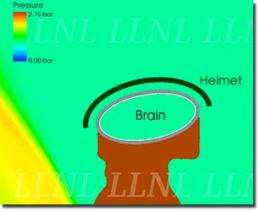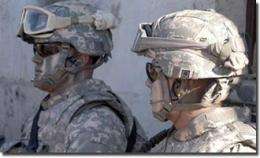How blast waves cause human brain injury even without direct head impacts?

New research on the effects of blast waves could lead to an enhanced understanding of head injuries and improved military helmet design.
Using numerical hydrodynamic computer simulations, Lawrence Livermore scientists Willy Moss and Michael King, along with University of Rochester colleague Eric Blackman, have discovered that nonlethal blasts can induce enough skull flexure to generate potentially damaging loads in the brain, even without direct head impact.
Traumatic brain injury (TBI) results from mechanical loads in the brain, often without skull fracture, and causes complex, long-lasting symptoms. TBI in civilians is usually caused by direct head impacts resulting from motor vehicle and sports accidents. TBI also has emerged among military combat personnel exposed to blast waves. As modern body armor has substantially reduced soldier fatalities from explosive attacks, the lower mortality rates have revealed the high prevalence of TBI.
There has been extensive research on how head impacts, for example from automobile accidents, cause traumatic brain injury (TBI). But TBIs resulting from blast waves without head impacts have not been well understood.
To tackle this puzzle, the team used three-dimensional hydrodynamic simulations to prove that direct action of the blast wave on the head causes skull flexure, producing mechanical loads in brain tissue comparable to those in an injury-inducing impact, even at nonlethal blast pressures as low as 1 bar above atmospheric pressure.
In particular, the team showed that blast waves affect the brain very differently from direct impacts. The primary source of injury from direct impacts is the force resulting from the bulk acceleration of the head. In contrast, a blast wave squeezes the skull, creating pressures as large as an injury-inducing impact and pressure gradients in the brain that are much larger. This occurs even when the bulk head accelerations induced by a blast wave are much smaller than from a direct impact.
The blast wave sweeps over the skull like a rolling pin going over dough," said King, LLNL co-principal investigator.
Although the simulations show that the skull is deformed only about 50 microns (the width of a human hair), "this is large enough to generate potentially damaging loads in the brain," according to Moss.

Because blast waves and direct impact affect the head in fundamentally different ways, armor systems that are designed to protect soldiers from impacts and projectiles may not be optimal for blast wave protection. The team studied how helmets and their suspension systems influence the blast-induced mechanical loads in the brain. They looked at two common systems: a nylon web system formerly used in the Personnel Armor Systems Ground Troops infantry helmet and viscoelastic foam pads like those in advanced combat helmets. Both helmets were modeled as hemi-ellipsoidal Kevlar shells.
In the first case, the 1.3 centimeter gap between the webbing and the shell allows the blast wave to "wash" under the helmet. In this case, the blast wave is focused by the shape of the helmet and the pressures under the helmet exceed those outside, so the helmet doesn't prevent the rippling deformation of the skull and pressure gradients in the brain.
In the second case, this "under wash" effect is mostly prevented by the presence of the foam pads, but under blast loading, the pads can become stiffer so that the blast wave-induced motion or deformation of the helmet is transferred to the skull. This can result in dangerous loads in the brain.
"The possibility that blasts may contribute to traumatic brain injury has implications for injury diagnosis and improved armor design," Moss said.
Blackman added: "By comparing the effect of blasts on the head with the effect of head impacts we'd be able to make some sense of the distinct mechanisms of injury, the damage a solider might incur, and how a helmet might be designed to minimize both."
More information: The research appears online Aug. 26 in Physical Review Letters.
Source: Lawrence Livermore National Laboratory














